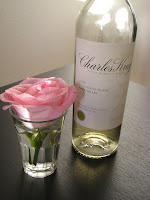 How do you judge wine? For most of us, we're having wine while socializing with others, whether at a happy hour or at dinner or at an event. During those times, it may be hard to take note of all the things we taste in a wine. What we may remember most is whether we like the wine or not.
How do you judge wine? For most of us, we're having wine while socializing with others, whether at a happy hour or at dinner or at an event. During those times, it may be hard to take note of all the things we taste in a wine. What we may remember most is whether we like the wine or not. Such was the case during this evening's brief tasting event. The St. Supery team came out to Google and had a full range available for tasting - their Sauvignon Blanc, Cabernet Sauvignon, Petit Verdot, and Moscato.
I was impressed by how delicate the Sauvignon Blanc was, and it went great with the paired oysters! This is a wine that I felt can hold its own with or without food, with its melon and slight chrysanthemum aromas.
The Cab, on the other hand, was unbalanced with excessive oak.
The Petit Verdot was surprisingly tasty! This grape is traditionally used as a blending grape in Bordeaux blends to add tannin, colour, and to strengthen the mid-palate. Since the varietal generally ripens later than most other grapes, there is a higher risk of losing the crop and thus, may not always be used. Perhaps California has just the perfect weather for ripening the grapes given the warm sunny and more predictable climate. This wine was full, easy to drink, and nicely fruit forward. This wine can be enjoyed at a casual dinner or cheese picnic.
Interestingly, St. Supery provided cocktail recipes for its Moscato. Generally, I drink wine for its own character, so to be introduced as a cocktail ingredient was a new concept! When I tasted the Moscato, I could understand why. This wine had all the honeysuckle and rose flavours that a general Moscato offers, and at the same time, it's simple. This wine would definitely enhance a cocktail well!
I enjoyed the tasting and the energy of the St. Supery gang. It was a great way to start the evening before attending the Cirque du Soleil performance in San Jose, Ovo! At the end of the day, that's what's most meaningful, that we're enjoying ourselves with our wine, whether we taste pear or honeysuckle or blueberries or dark cherries or vanilla or spice!




